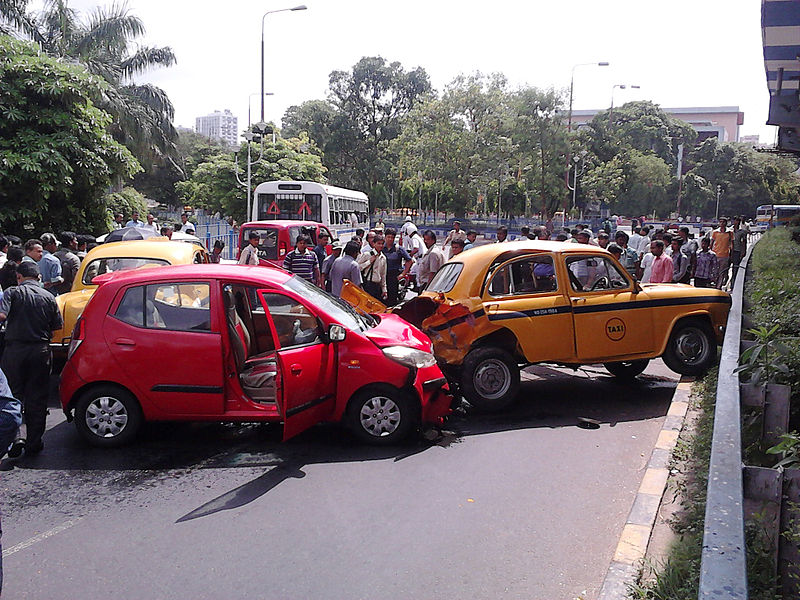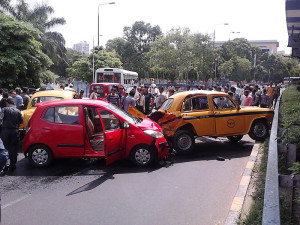
This article is written by Pragya Dhoundiyal.
In the wake of rise in the number of road accidents, the government has put its foot down in order to revamp the existing laws relating to carriage by road. Reportedly around 5 lakh accidents take place in India annually with a death toll of around 1.4 lakh. India has the highest proportion of deaths due to road traffic accidents in South East Asia. The situation is problematic in India because of lack of proper infrastructure facilities, poor road designs, poor implementation of traffic rules and regulations and a high load of a range of vehicles on the roads. In order to curb the menacethe Road Transport and Highways Ministry recently unveiled the draft Road Safety and Transport Bill 2014, which is out on their portal for the public and the stakeholders to give in their suggestions. The bill has been drafted to be in sync with the six advance nations – USA, Canada, Singapore, Japan, Germany and the UK. The bill would be presented in the winter session when the fate of the bill will be decided.
Missions and aims of the draft bill:
Their mission is to provide safe, efficient, cost effective and faster transport across the country. It aims to bring down the casualty caused by rash and negligent driving by coming down hard on the violators. This aims at bringing down the fatality rate by two lakh in the first five years of the implementation of the proposed changes. It is expected that the improved efficiency and safety of road transport would improve the GDP by 4% which would further enhance the investments in this sector and lead to creation of about 10 lakh jobs.
Proposed changes:
Establishment of motor accident fund: There is a marked emphasis on e-governance to bring in transparency in the functioning of the whole mechanism. Another commendable feature is the ‘golden hour’ policy which would ensure that all efforts are made to provide help to the road accident victims within an hour of the occurrence accident. Very evidently those are the crucial moments when a life can be saved, many instances of death occur because of untimely help that is provided as people tend to avoid helping the victim in order to escape the legal tangles. The aspect of monetary relief to the victim will also be taken care of with the establishment of a motor accident fund.
Enhanced fines and penalties: The pecuniary fines have also seen an increment which is expected to act as a deterrent. In case a person is caught using a vehicle in unsafe conditions, the person might be asked to pay a penalty of Rs.1 lakh or imprisonment for 6 months, which might be extended to one year.
Another offence that saw an enhancement of fine is the offence for drunk driving. In this case if a person is caught violating the law for the first time, s/he is expected to pay a Rs.25,000, or imprisonment for a term not exceeding 3 months, or with both, and a 6 months license suspension. On catching the same violator violating the same law would result in Rs.50,000 penalty or imprisonment for up to 1 year or both and a one year license suspension. But any subsequent violation would result in the cancellation of the license, and impounding of the vehicle which may extend for 30 days. Another rider to this clause is that if the person caught drunk driving is a school bus driver then the fine imposed would be Rs.50,000 with an imprisonment for 3 years with immediate cancellation of license in case the drivers involved in the incidence fall in the age bracket of 18 to 25 years. This provision is a welcome step as the drivers in this case have an added responsibility of so many lives that would play a crucial role in framing what tomorrow’s India would look like.
In case death of a child is caused, then in certain circumstances it will result in Rs.3 lakh fine, and imprisonment for a term not less than 7 years. In order to curb the growing impatience in the public which impels them to skip signals, the bill says that violating traffic signal three times would result in Rs.15,000 fine, license cancellation for a month and a compulsory refresher training.
Fines for faulty manufacturing designs: In case of faulty manufacturing design also the bill proposes to impose a hefty penalty of Rs.5 lakh per vehicle. The bill has very comprehensively attempted to cover most of the aspects which have been plaguing our safety provisions. The fines will be imposed by a graded point system.
It is intended that steps would be taken on the technological front as well. In order to promote innovation, vehicle types would be approved within a given span of time. There will be efforts in the direction of making spare parts cheaper by conforming to and adopting new technology like intelligent speed adaptation, driver alert control, eye drowsiness detectors, distance closure rate detection and green box monitoring. In the process safety will not be compromised and attempts to include safety equipments would be made, and to adopt new standards the industries would be provided with lead-time.
Motor Vehicle Regulation and Road Safety Authority of India: The bill proposes to build an independent agency for vehicle regulation and road safety – Motor Vehicle Regulation and Road Safety Authority of India. It would be a legally empowered institutional setup which would be accountable to the parliament. It will aim at coming up with innovative financing mechanism for funding safety programs which would give further impetus to the ‘make in India’ movement.
National Road Transport and Multinational Coordination Authority: In order to improvise the existing process, there would be a unified vehicle registration system, single National Road Transport and Multinational Coordination Authority (for improving quality of road transportation, developing integrated transport system by ensuring last mile connectivity by feeder bus services and multi modal hubs) and Goods Transport and National Freight Policy ( for increase in logistics to combat inflation by steps like simplified and single portal clearance, addressing the bottlenecks of the trucking industry etc); a transparent single-window automated driving license system including biometric systems to avoid license duplication.
The application and issuance procedures for driving licensing system would be simplified and technology would be adopted for driver testing facilities.
As the emphasis of the whole growth process now lies on integrating private sector in key areas of development, this field is no exception, like they will now participate in establishing fitness certification centres. At the same time condition of the existing public passenger transport will be worked on and made eco friendly. There would be a two tier permit system, one at national level and the other would be intra state. The transfer of vehicles across the states would be made easier and integration of all stakeholders would take place.
Conclusion:
The well intentioned draft does project a promising image on paper but the implementation of the provisions will be the real acid test. Bribery which is ubiquitous in all levels of the government is the major apprehension of the common man, with the enhancement of the penalties there is a possibility that the amount demanded as bribes might also rise. So energies must be invested in making the police department corruption free if we really want to see the effect of the strict legislation. Only after a mechanism to check corruption is in place that charging such high fines would be justified, after all the people who cause accidents enjoying the comfort of their SUVs should also feel the pinch.
Stricter norms for passing the driving test can go a long way in curbing the grim situation that exists at present. It is not hidden from anybody that licenses in India can be obtained through a ‘dalal’ without undergoing the test.
Some infrastructural defects are also responsible for causing accidents like the sharp turns, or a tree suddenly erupting in the middle of the road. The shoddy conditions of the roads have claimed the lives of many innocents. Not only should the drivers of the vehicles be made liable but also the pedestrians who do not take the pain to walk a few steps more in order cross the road by using subways, foot over bridges or the zebra crossings, should also be brought to book.
We will have to wait to see what shape does the final act take and how well does it help in tackling the problems that the country is grappling with.
Photo credits: Biswarup Ganguly uploaded at Wikimedia Commons.
 Serato DJ Crack 2025Serato DJ PRO Crack
Serato DJ Crack 2025Serato DJ PRO Crack




 Allow notifications
Allow notifications

Road safety and Transport bill, Is a welcome step. But it is an absolutely one sided Bill being introduced.
Is there NO responsibility of the ‘Other Road Users’ – Pedestrains,Cyclists,Two wheelers and other road users. There has to be a bill for them, the Mechanicl transport can not be singularly and solely be held responsible
What about the Government bodies -NHIA, CPWD, Municipal Corporation, Police and other agencies who are to implement various rules and regulations, sign postings, regulation of all road users
More over heavy vehicles are held responsible always, but have you ever realised that the smaller vehicles squeeze themselve in, not giving them enough room and space to manage the heavy vehicles and breaking distance. The driver is pearched high and can not see below his nose, where all types of small transport vehicles and road users pit them selves causing accidents
The bill drafters appear to be short sighted, they have to bring in a comprehensive bill
Col U S Gill
This could be a revolution for our country. This massive change could actually benefit people. development of more mobile applications life Traffline could also help in mitigating the road accident ratio because these are the things people use and follow nowadays with vast evolving technology.